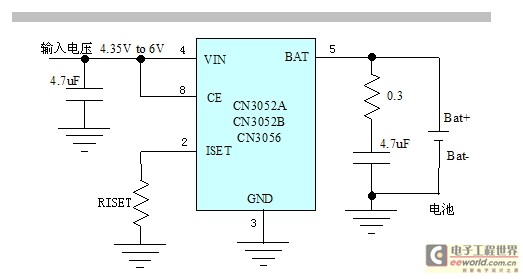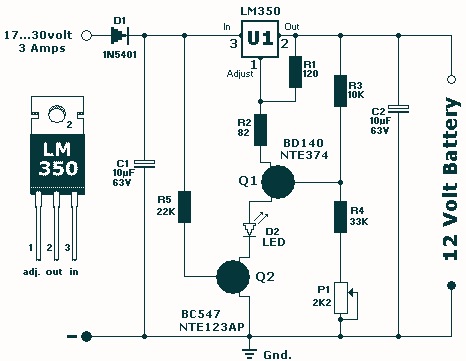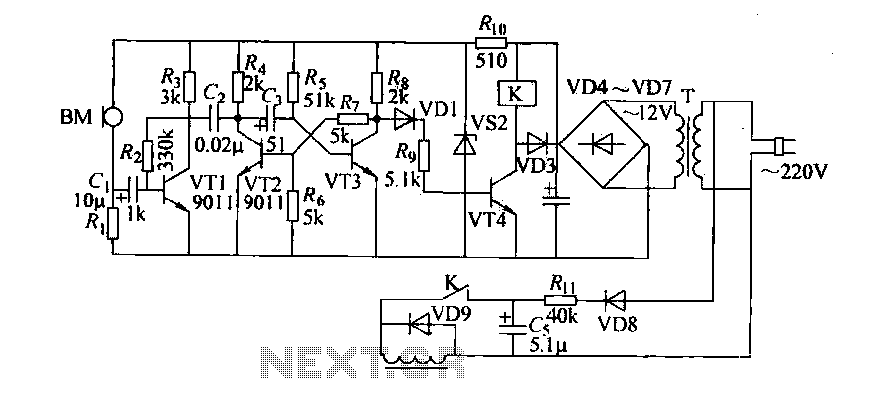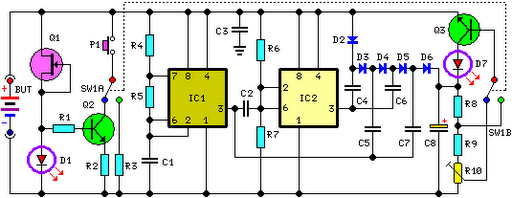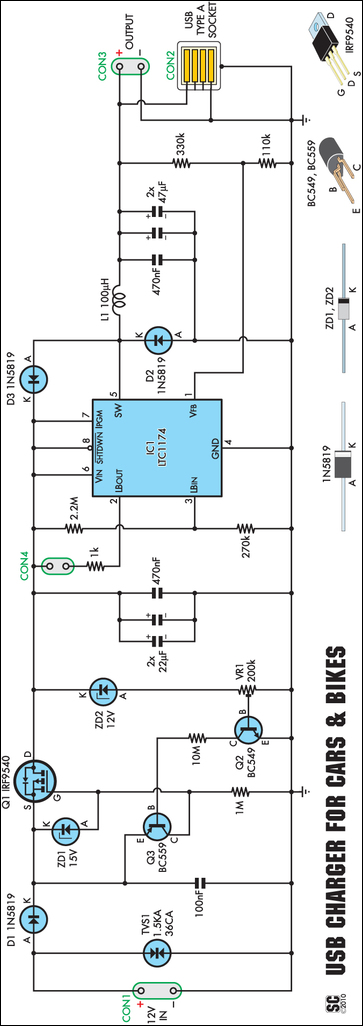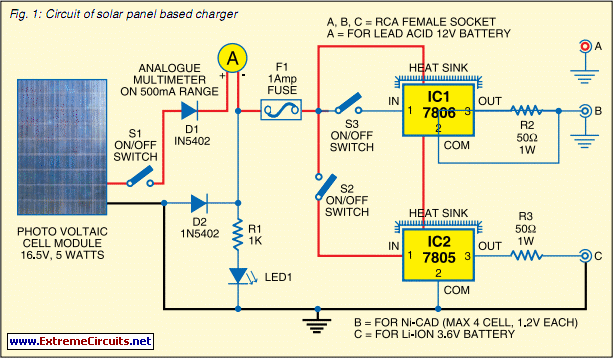
Automatic Battery Charger
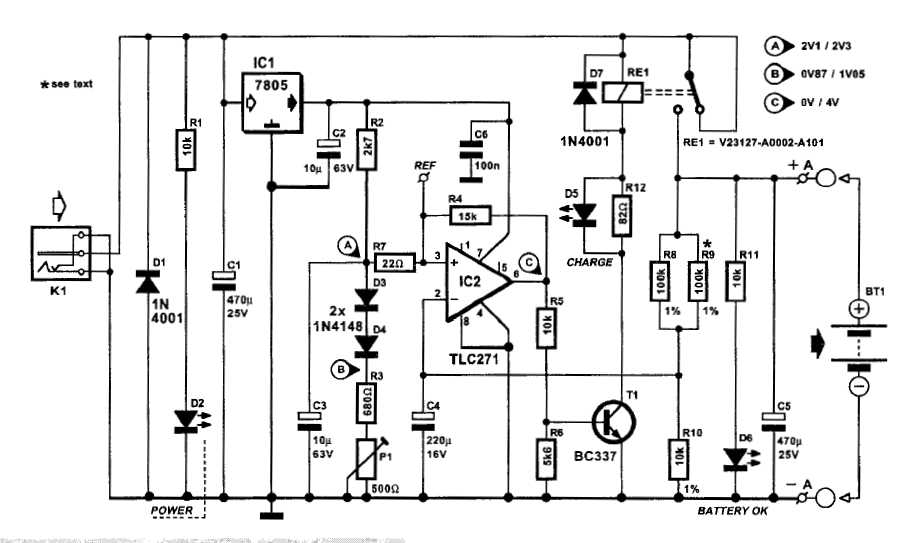
An automatic battery charger initiates the charging process when the battery voltage falls below a specified threshold and ceases charging once the voltage exceeds a predetermined maximum value. The setup is straightforward; simply connect two alligator clips to the battery terminals and plug the device into the mains supply. This allows the charger to remain connected for extended periods without the risk of overcharging the battery. This feature is particularly useful for scooters or motorcycles that are not used during the winter months, as batteries can deteriorate when left unused, especially in cold weather.
The automatic battery charger operates through a voltage sensing mechanism that continuously monitors the battery voltage. When the voltage drops below a predefined level, typically around 12.4 volts for lead-acid batteries, the charger activates its charging circuit. This is often accomplished using a relay or a solid-state switch that engages the transformer or switching power supply, providing the necessary current to the battery.
The charging process usually involves a multi-stage approach, which may include bulk charging, absorption, and float charging stages. During the bulk charging stage, the charger delivers maximum current until the battery voltage reaches the absorption level, typically around 14.4 to 14.7 volts. At this point, the charger switches to the absorption stage, where it maintains the voltage while the current gradually decreases, allowing the battery to reach full capacity without overheating.
Once the battery is fully charged, the charger transitions to the float charging stage, where it applies a lower maintenance voltage, usually around 13.2 to 13.5 volts. This keeps the battery topped off without overcharging, ensuring its longevity and readiness for use when needed.
The design of the charger may include additional features such as LED indicators to show the charging status, protection circuits to prevent reverse polarity connections, and thermal protection to avoid overheating. Furthermore, modern chargers may incorporate microcontroller-based systems for enhanced monitoring and control, allowing for more precise voltage and current regulation.
This automatic battery charger is an essential tool for maintaining the health of batteries in vehicles that are not used frequently, particularly in harsh winter conditions, ensuring that they remain in optimal condition for when they are needed.Automatic battery charger automatically starts the charging procedure when battery voltage drops below a certain predefined value and stops after the voltage has risen above the maximum allowed value. Setup can`t be easier, just connect two alligator clips to battery terminals and plug the device in mains.
This way it can stay connected for months and the battery will never overcharge. This comes very very handy when you have a scooter or a real motorcycle that you don`t drive during the winter time. Because we all know what happens to a battery when not used and especially during the winter 🔗 External reference
The automatic battery charger operates through a voltage sensing mechanism that continuously monitors the battery voltage. When the voltage drops below a predefined level, typically around 12.4 volts for lead-acid batteries, the charger activates its charging circuit. This is often accomplished using a relay or a solid-state switch that engages the transformer or switching power supply, providing the necessary current to the battery.
The charging process usually involves a multi-stage approach, which may include bulk charging, absorption, and float charging stages. During the bulk charging stage, the charger delivers maximum current until the battery voltage reaches the absorption level, typically around 14.4 to 14.7 volts. At this point, the charger switches to the absorption stage, where it maintains the voltage while the current gradually decreases, allowing the battery to reach full capacity without overheating.
Once the battery is fully charged, the charger transitions to the float charging stage, where it applies a lower maintenance voltage, usually around 13.2 to 13.5 volts. This keeps the battery topped off without overcharging, ensuring its longevity and readiness for use when needed.
The design of the charger may include additional features such as LED indicators to show the charging status, protection circuits to prevent reverse polarity connections, and thermal protection to avoid overheating. Furthermore, modern chargers may incorporate microcontroller-based systems for enhanced monitoring and control, allowing for more precise voltage and current regulation.
This automatic battery charger is an essential tool for maintaining the health of batteries in vehicles that are not used frequently, particularly in harsh winter conditions, ensuring that they remain in optimal condition for when they are needed.Automatic battery charger automatically starts the charging procedure when battery voltage drops below a certain predefined value and stops after the voltage has risen above the maximum allowed value. Setup can`t be easier, just connect two alligator clips to battery terminals and plug the device in mains.
This way it can stay connected for months and the battery will never overcharge. This comes very very handy when you have a scooter or a real motorcycle that you don`t drive during the winter time. Because we all know what happens to a battery when not used and especially during the winter 🔗 External reference
Warning: include(partials/cookie-banner.php): Failed to open stream: Permission denied in /var/www/html/nextgr/view-circuit.php on line 713
Warning: include(): Failed opening 'partials/cookie-banner.php' for inclusion (include_path='.:/usr/share/php') in /var/www/html/nextgr/view-circuit.php on line 713
